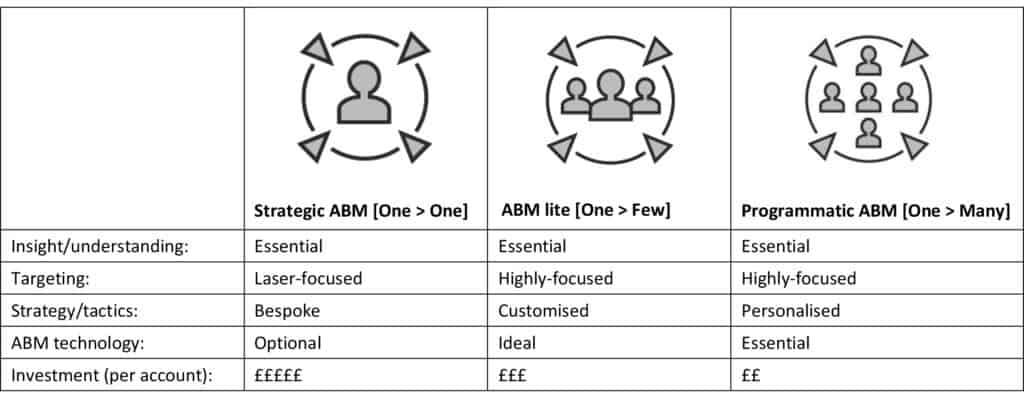10 things you need to know before you get started with ABM.
27th August 2019 • 5 min read
27th August 2019 • 5 min read

If you’re a B2B marketer you’ve probably heard a lot of talk about Account Based Marketing (ABM) recently. It’s true that there’s a lot of noise out there right now about ABM, and in particular a lot of Martech vendors are putting their own spin on it. This makes for a complicated and slightly fuzzy picture of what ABM actually is.
So, to help clear things up, here’s my unbiased introduction to ABM that answers some of the most common questions, and gives some practical advice about getting started.
As marketers, we all know that the fundamentals of successful communication are all about right message, right audience, right time. The more focused the audience and the better the audience insight – the more successful your campaign will be. Essentially, ABM is about taking these fundamental principles to the next level to create strategies, propositions, content and creative communications for specific individuals in high-priority accounts.
In a nutshell, ABM is about marketing to segments of one. Or to use the definition of ABM provided by Information Technology Services Marketing Association (ITSMA): Account-based marketing, put simply, is “treating individual accounts as markets in their own right.”
It’s important to recognise that ABM is much more than a marketing tactic. ABM is a long- term strategic business initiative. It requires buy-in from senior stakeholders in your business and a need for sales and marketing teams to work more closely than ever before to provide customers and prospects with a completely joined-up experience through every stage of the buying journey.
Although the foundational principles of ABM and demand generation are the same, the methodologies are very different. With a traditional demand generation approach, the role of marketing tends to be focused at the top of the funnel, with success measured on engagement metrics and the volume of leads generated – then it’s over to the sales team to close the deal. With ABM there is no top of the funnel – you choose the businesses you want to go after.
So, rather than casting a wide net and hoping that some good opportunities swim into it, you identify the big opportunities and focus on catching them. To take the analogy further, if traditional demand generation is like fishing with a net, then ABM is fishing with a spear.
ABM really works. There’s plenty of evidence of tangible, measurable benefits being reported by lots of businesses that have adopted ABM. According to ITSMA, 70% of organisations that implemented ABM substantially improved their account revenue, and 89% of businesses report an increase in deal size with ABM, as noted in Sirius Decisions’ State of ABM report.
For me there are also some really significant cultural benefits. ABM brings better alignment between sales and marketing teams within businesses. In my experience, these two functions often have a difficult relationship with one another. By adopting an ABM approach, marketing and sales teams need to work more closely. From identifying the target accounts, through to developing strategies, and even the deployment and reporting of success. In an ABM world, sales and marketing teams share the same targets and share in each other’s successes.
More than anything else, I love the fact that ABM is prompting businesses to rediscover the value of audience insight.
This is the question I get asked more than any other, but it’s also a bit of an oxymoron. When we talk about ABM at scale, we’re really talking about programmatic ABM (or one-to-many ABM). It’s a relatively new concept that’s been enabled by new technology platforms in the last few years. This approach allows businesses to use some very clever technology to extend their ABM propositions and content to a much wider pool of accounts.
As an ABM purist I would argue that Programmatic ABM isn’t really ABM at all, but regardless of what you call it, it’s undeniably a powerful way to extend the value of your investment in ABM and lower the risk of ABM adoption.
If you want to implement ‘ABM at scale’ you will need to invest in an ABM platform. Some of them are really impressive, but they can also have a hefty price tag to match.
ITSMA defined three different types of ABM in the 2010 practitioners Guide to ABM, and today this terminology has become prevalent among marketers and ABM experts.
The three types of ABM are:
i. Strategic ABM, or one-to-one ABM: This approach focuses on target accounts on a completely individual level. When adopting a Strategic ABM approach, you’ll look to understand everything about the business and the individual stakeholders within the decision-making unit. You’ll design strategies, propositions, and content that speak to their individual challenges. The approach will be completely bespoke, designed specifically for that account.
ii. ABM lite, or one-to-few ABM: This approach focuses on a handful of target accounts which have a level of commonality – typically around shared challenges. With an ABM lite approach, you’ll be creating strategies, propositions and content that can be tailored to each of the accounts. An ABM lite programme would typically focus on between 5 and 20 accounts.
iii. Programmatic ABM, or one-to-many ABM: Essentially this a hybrid between ABM and demand generation and can be used to supplement one of the other two approaches. Programmatic ABM uses technology to intelligently deploy your messaging and content to accounts that demonstrate similar behaviour to your priority target accounts

The criteria that make a best-fit account for you will be different from what makes a best-fit account for another business. Your account selection criteria are likely to take several factors into account. These might include the potential value of the business, their current position in the sales cycle for a product/service like yours, existing contacts and relationships within the account, or even the prestige that landing a certain account would bring.
One thing that is certain is that you should work closely with your sales team to select the target accounts for your ABM programme. They will understand better than anyone where the big opportunities are. And by working with sales to set the direction of travel they’ll be engaged from the outset.
Unlike the traditional demand generation where the marketing team is responsible for delivering MQLs (Marketing Qualified Leads) and then passing the baton to sales teams to pick up the relationship and close the deal, successful ABM aims to deliver seamless, tailored customer experiences throughout the customer journey. Sales and marketing work together to understand customer challenges at every stage and collaborate to create and deliver customised content – relevant to the specific target.
Both. ABM has proven to be really successful for in both scenarios: landing net-new business and expanding into existing accounts. In both scenarios, ABM is widely acknowledged to increase average deal size. According to the Sirius Decisions, State of ABM Report, 89% of businesses report an increase in deal size with ABM.
Yes and no. ABM is all about quality rather than quantity. So, while there is a bigger investment in planning, strategy and content creation per account, you’ll only be focusing on a handful of carefully selected opportunities.
Don’t forget – ABM is a long-term ongoing commitment which will require funding to match.
There are some ABM budget calculators available online. By all means give them a try – they will help you to understand a base level investment required but remember the very nature of ABM means that the approach you adopt for one account could be very different to the one you adopt for another. Therefore, you should take these calculations with a pinch of salt.
While the current narrative around ABM features a lot of talk about technology platforms, implementation of lots of new tech isn’t a requirement. We have worked with clients to execute both high-tech and low-tech ABM programmes.
Intent data platforms can be used to provide amazing insights in the early phases of an ABM programme; social media (LinkedIn, Facebook, Twitter, etc.) can be hooked up to deliver tailored ABM messages and content; ABM platforms can be employed to amplify your programme and your CRM can be hooked up to monitor attribution.
We can support you with all of this – however, for me the methodology is more important than the technology. Focus on getting the strategy right first, and then use technology to take your ABM programme to the next level when you’re ready.
In my opinion, if you focus on the technology first and foremost, you’re likely to miss the real value and opportunities that ABM offers.
If you’re keen to get started with Account Based Marketing, an ABM pilot programme is a good way to go. We’ve helped several of our clients start their own ABM journey in this way. We believe that the key to successful ABM is about getting to grips with the methodology first and then introducing the technology if and when you’re ready. We recommend building a pilot programme that uses the tools you already have in play and leverages the knowledge and expertise in your business. By following a straightforward process, you can start your own ABM journey in this way.
If you’d like to learn more about getting your own ABM pilot up and running, you can get in touch for more information and best practice ABM tips and advice.
Talk to us today